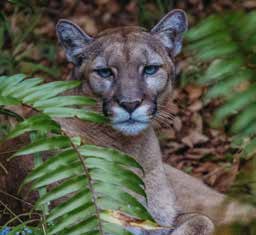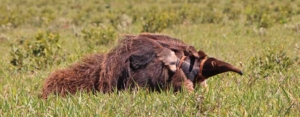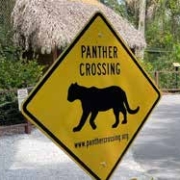Wildlife, Roads, and The Lake Wobegon Effect

by Tim L. Tetzlaff, Naples Zoo Director of Conservation
It’s January 26, 2023. I’m on Zoom call where my emotions swing between disheartened and hopeful. I’m joined in Naples by Painted Dog Research Trust Executive Director Dr. Greg Rasmussen in from Zimbabwe as he shares the literal impact of vehicular collisions on this critically endangered species. To seek solutions, I’ve set up this call with experts who share his challenges. His data is emotionally punctuated with graphic photos. It’s heartbreaking.
As Dr. Arnaud Desbiez begins sharing, I recall seeing giant anteaters lying alongside Brazilian highways. As project coordinator of Anteater & Highways, their multiyear research revealed a staggering annual loss of 64 anteaters per 100 miles of road – but also how that led their state government to implement mitigation measures for new road construction. I’m encouraged.
 A panther biologist reinforces the success of our own I-75 fences and underpasses and a renowned road ecologist on the call then reinforces that expensive infrastructure such as that is the most successful at saving human and animal lives. Of course, Greg recaps that Zimbabwe is short on funds and abundant on elephants that tear down fences. Even here in Florida where infrastructure is absent, a panther faces twice the risk of getting in car crash as you and me and is 100 times more likely not to survive. Positivity is waning.
A panther biologist reinforces the success of our own I-75 fences and underpasses and a renowned road ecologist on the call then reinforces that expensive infrastructure such as that is the most successful at saving human and animal lives. Of course, Greg recaps that Zimbabwe is short on funds and abundant on elephants that tear down fences. Even here in Florida where infrastructure is absent, a panther faces twice the risk of getting in car crash as you and me and is 100 times more likely not to survive. Positivity is waning.
The road ecologist warns that cost-effective solutions like reduced posted speeds in wildlife crossings are attractive, but research confirms most people ignore the risk. After all, driving fast is fun and our roads are designed for efficiency so uninformed drivers mistakenly assume speeding in crossing zones is safe even at night when it’s most dangerous. Compounding this is The Lake Wobegon Effect (aka illusory superiority) named after A Prairie Home Companion’s fictional town “where all the women are strong, all the men are good-looking, and all the children are above average.” Amusing in fiction, but when over 90% of drivers rank themselves better than all others, that false confidence isn’t benign. 
Then the IUCN Behavior Change Coordinator fascinates me with her line of questioning and agrees to a follow up meeting with Greg and me. I finish the call 30 minutes over time and beyond grateful that experts like these are so engrossed in the discussion to help a colleague.
While the greater challenge remains, there is a simple personal solution available to me and anyone willing to act: Be smarter than the average driver. And that can start with a Socrates-style realization that most of us are the average driver. Here are some thoughts I use to keep rooted in reality.
1) Braking distance increases exponentially with speed and reaction time isn’t immediate. At 50 mph, I need half a football field to stop. But at 70 mph, I’d be far into the end zone. Wet pavement? I’m in the locker room.
2) Having a decent chance avoiding an animal as large as a moose at night requires driving 40 mph – hence the wisdom of the 45-mph nighttime speed in panther crossing zones.
3) Young drivers have more overall crashes, but shockingly there is no spike on the graph for them with wildlife collisions – suggesting animals on roads are like kryptonite to my driving skill.
4) Driving the nighttime speed in a 3-mile wildlife crossing only adds 60 seconds to my drive offset by the lifegiving benefits of reducing my urge to swerve away into a canal or head-on collision.
 Join me in getting your panther crossing sticker reminder at www.panthercrossing.org. And when we see those around Naples that can make us all feel hopeful!
Join me in getting your panther crossing sticker reminder at www.panthercrossing.org. And when we see those around Naples that can make us all feel hopeful!




Leave a Reply
Want to join the discussion?Feel free to contribute!